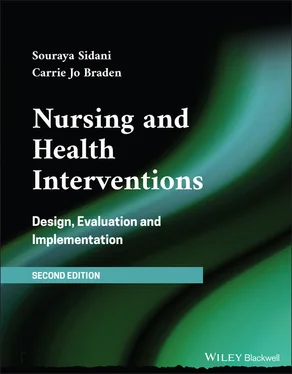Results of descriptive longitudinal studies indicate changes in the experience, indicators, and severity levels of the health problem over time. Awareness of changes in the problem experience over time is informative as it guides the selection of the timing, within the health problem trajectory, for delivering the intervention; of the optimal dose at which the intervention is given which may incorporate “booster” sessions to prevent relapse; and the organization or sequence with which the intervention components are offered.
Results of correlational cross‐sectional studies support the existence, direction, and magnitude or size of the associations between the health problem, and its determinants. They shed light on the nature of the relationships (i.e. whether direct or indirect) between the problem and determinants. Findings of correlational longitudinal studies provide evidence of the sustainability or changes in the existence, direction, or magnitude of these relationships over time; they have the potential to identify the temporal sequence linking determinants to the problem, which is required to support naturally occurring causal linkages. For example, cross‐sectional evidence has long supported the existence of a positive correlation between insomnia and depression; but it was not clear which of these two problems caused the other. Recent longitudinal evidence suggests that insomnia predicts depression and that interventions addressing insomnia could contribute to improvement in depression and not the other way as implied in cross‐sectional evidence (e.g. Fernandez‐Mendoza et al., 2015).
Review of Qualitative Studies
Qualitative studies to include in the review are those that focused on exploring the experience of the health problem from the clients' perspective. Clients are well known to hold implicit theories of the health problem; these theories reflect their personal construction of the problem and explanation of contributing factors (Armstrong & Dregan, 2014). Qualitative studies using different approaches (e.g. phenomenology, grounded theory) are selected if they aim to describe clients' experience of the problem (e.g. indicators, impact on daily life); elucidate factors that contributed to the problem; or generate a theory or a model summarizing and explaining the intricate relationships among the determinants and the problem. Results of qualitative studies highlight the unique way in which the health problem is experienced by particular subgroups of the client population. They also assist in clarifying the pathway linking the determinants with the problem and in providing conceptual explanations of these associations.
Many types of literature reviews are useful in developing a comprehensive understanding of the health problem. These are well described by Snilstveit et al. (2012), Paré et al. (2015), and Hong et al. (2017). Of interest to the generation of an understanding of the health problem are reviews that synthesize theoretical or conceptual knowledge and quantitative and qualitative empirical evidence related to the problem experience and its associations with determinants.
Theoretical or conceptual reviews are exemplified with concept analysis (Hupcey & Penrod, 2005) and framework synthesis (Carroll et al., 2013). Essentially, these consist of reviewing theoretical, empirical, and sometimes grey literature, for the purposes of: clarifying the attributes of the health problem; defining it at the theoretical and operational levels and distinguishing it from related concepts or problems; and identifying its determinants.
Quantitative reviews include systematic reviews, meta‐analyses, and umbrella reviews that focus on the relationships among determinants and the health problems. The reviews apply a systematic process for searching the literature; identifying and selecting studies that meet the pre‐specified criteria; appraising the study quality; and extracting data on the existence, direction, and magnitude of the associations between the determinants and the problem. However, they differ in the method for synthesizing the evidence. Systematic reviews use vote count or content analysis to integrate evidence on the associations. Meta‐analyses use statistical techniques to estimate the direction and magnitude of the association reported in each study; to determine the extent of variability in the estimates across studies. When the variability is minimal, the estimates are synthesized to indicate the average level of associations between the problem and its determinants. Where there is high variability, statistical tests are used to identify conceptual and/or methodological factors that account for the observed variability in the estimates. Recently, umbrella reviews (also called reviews of reviews, meta‐reviews or meta‐evaluation/meta‐epidemiology; Gough et al., 2012) have been conducted to compare, contrast, reconcile, and/or explain differences in the results of systematic reviews and meta‐analyses (Paré et al., 2015). Findings of systematic reviews, meta‐analyses, and umbrella reviews indicate: the extent to which the associations between the determinants and the health problem exist within particular client populations and contexts, or are replicated across populations and settings; the expected direction and magnitude (or size) of the associations; and the factors that moderate the associations.
Meta‐syntheses entail methods for integrating findings of qualitative studies (Edwards & Kaimal, 2016) that investigated the health problem. Examples of methods include meta‐ethnography and thematic synthesis that consist of searching the literature, identifying and selecting relevant studies, extracting and coding the findings of each study, then comparing and contrasting the codes to generate themes (Sandelowski & Barraso, 2007; Snilstveit et al., 2012). The themes can provide a list of determinants and explanation of the inter‐relationships among the determinants and the problem, embedded within or across contexts.
Mixed reviews are increasingly performed to understand the health problem. They consist of integrating evidence synthesized from quantitative and qualitative studies. Mixed reviews are justified with the increasing complexity of the inter‐relationships among determinants (occurring at different levels) and health problems (experienced in different domains), and the acknowledgement of the unique and complementary contribution of quantitative and qualitative research methods (Edwards & Kaimal, 2016; Fleming, 2010; Hong et al., 2017). Mixed method reviews (e.g. critical interpretive synthesis) follow the same steps for searching the literature; identifying, selecting, and appraising quantitative and qualitative studies; and extracting data on the experience of the health problem and its determinants from each study. In some mixed‐method reviews, the synthesis is conducted separately for the quantitative (e.g. through vote counting, estimating effect size) and the qualitative (e.g. coding, generating themes) findings; then, the synthesized quantitative and qualitative evidence is compared and contrasted to identify convergence and divergence. In other mixed‐method reviews, the quantitative and qualitative data are integrated (i.e. brought together) during the analysis and synthesis stages of the review.
The integration of the quantitative and qualitative evidence can be done by aggregation or configuration. Aggregation is used when quantitative and qualitative findings address the same association between a determinant and the health problem, and the purpose is to examine convergence (i.e. whether the findings confirm each other). The aggregation may be accomplished at the data or study level. Data‐based aggregation involves the transformation of one type of data into another (e.g. quanticizing qualitative codes/themes) and analyzing the transformed data using the same analytic method (e.g. descriptive statistics). Study‐based aggregation consists of juxtaposing the findings of quantitative and qualitative studies, using grids, tables or matrices, where the interface between the two types of findings occurs in the cells; the latter evidence is compared and contrasted to identify convergence (Fleming, 2010; Hong et al., 2017). Aggregation by configuration entails the arrangement of diverse findings into a coherent form or model. The quantitative and qualitative findings are carefully examined and analyzed to determine if they complement, extend, explain each other (e.g. why and how a determinant contribute to the health problem), or reflect variability in the problem experience and in the association of the determinant with the problem in different contexts (Sandelowski et al., 2012).
Читать дальше












